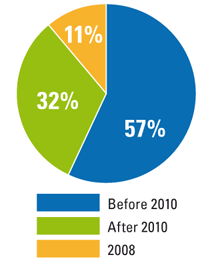Technical
Countdown to Eurocode Implementation
Progress on National Annexes
Unfortunately, there is little news about the publication of key National Annexes. The National Annex to the wind load- ing part, BS EN 1991-1-4 has still not been published – it is indicated that this should be by 31 May, although it is likely to be later, and accompanied by a short Published Document (PD). The PD fol- lows from the calibration exercise that compared BS 6399-2 with the Eurocode values, and will give guidance on certain coefficients.
The National Annex to BS EN 1993-1-1 (general rules and rules for buildings) is anticipated at the end of June. The Na- tional Annex to Part 1-8 (design of joints) is anticipated at the end of July. Although this gives more time to complete the suite of design guidance, the delay does mean that the publication dates are moving towards summer. Many publications (for example the new Blue Book, as described later in the journal) are held pending the publication of the Annexes. Although we are confident about the contents, it would be foolish to print if something changed at the last moment.
Latest dates are given on the Eurocode expert site http://www.eurocodes.co.uk
When to change?
One important issue is the timing of any change to the Eurocodes. National
Standards are supposed to be withdrawn in 2010. In the UK, the Building Regulations do not insist on any specific design Standard being used, so in theory it is possible never to design using the Eurocodes. It is likely that BS 5950 will be reviewed in 2009, and be available for use until at least 2015. In practice, it is likely that companies will change:
• Because design to the Eurocodes is specified
• Because of the advantages offered by the Eurocodes
• To have only one set of design Standards used within a practice – for materials, and for projects in different countries
• Because of insurance requirements.
As part of a project to produce on-line teaching material to the Eurocodes,
a number of UK practitioners were surveyed to discover their view on likely change dates. The majority (68% of around 250 results to date) reported that they would change to Eurocode design by 2010. Another interesting outcome from a smaller review group was the confidence that engineers (and in particular, younger engineers) had in their ability to design to the Eurocodes. Whilst none had received any significant training, all were confident that they would be competent in Eurocode design. The situation is very different in other countries, where the earlier versions of the Eurocodes have been used for many years, or where the National Standards have been based on the early Eurocodes. In such countries, the “change” to Eurocode design is not recognised – they are already being used.
Practical design situations wanted
The guides underway at present include an update of the publication on combined bending and torsion, and the publication on lateral stability. Both of these existing publications contain many design situations, and associated examples.
It would be good to hear from users of the existing guides about the coverage needed in the new Eurocode version. Are the situations realistic? Are there other common cases that should be included
in the Eurocode version? Please send any comments to Abdul Malik at the SCI.
Access Steel website
Increasing numbers of designers are using the website (see box), including other websites which reference the resources. The latest statistics show that there are around 10,000 users per month, requesting 80,000 pages. At the present time, only 20% of these are from the UK, which is interesting, given the imminence of a possible change to the Eurocodes. The worked examples and the interactive examples are one simple way in which engineers can compare designs to see the differences in approach, and the results.













